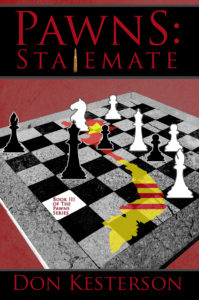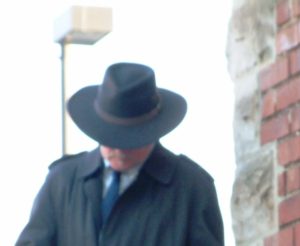 My third installment of my Vietnam Conflict series, Pawns: Stalemate, was released in paperback this week on Amazon. It is a behind the scenes story from one of the most volatile times in US history, the Vietnam Conflict. The Pawns series was started from seeing the bumper sticker: When I Left Vietnam, We Were Winning”. Growing up in the Vietnam era, I do not remember anyone ever discussing with me that the United States was ever winning in Vietnam. Therefore, I was seeking the truth, was the bumper sticker correct? This novel represents the final answer to my own personal question of the bumper sticker. It took two years of deep research and writing, seeking out only the facts regarding the Vietnam Conflict. I interviewed and discussed strategy and application with several of my friends and contacts who had honorably served in the United States military. Likewise, since growing up in that era, I knew and went to college with numerous anti-war protestors.
My third installment of my Vietnam Conflict series, Pawns: Stalemate, was released in paperback this week on Amazon. It is a behind the scenes story from one of the most volatile times in US history, the Vietnam Conflict. The Pawns series was started from seeing the bumper sticker: When I Left Vietnam, We Were Winning”. Growing up in the Vietnam era, I do not remember anyone ever discussing with me that the United States was ever winning in Vietnam. Therefore, I was seeking the truth, was the bumper sticker correct? This novel represents the final answer to my own personal question of the bumper sticker. It took two years of deep research and writing, seeking out only the facts regarding the Vietnam Conflict. I interviewed and discussed strategy and application with several of my friends and contacts who had honorably served in the United States military. Likewise, since growing up in that era, I knew and went to college with numerous anti-war protestors.
The novel picks up several months after the final scene of Pawns: Kings in Check, it begins in the middle of 1965, just as President Johnson orders a substantial increase of ground troops into Vietnam and ends after the TET Offensive at the beginning of 1968. It features the same fictional characters from previous novels in this series, Marine Major Steven Hebert and newspaper reporter Rita Sullivan inserted into the historically accurate timeline. The intent is to give the reader a feel for actually experiencing the events, while shining a light on the true history. Hebert and Sullivan serve their fictional roles juxtaposed in historical events in Vietnam and in the United States.
The Vietnam side of my research didn’t focus on specific battles, rather, the military strategy of the Conflict and the very difficult situation the US military was placed in while serving in that theater. The US side of my research dealt with the Johnson administration and the American public, mostly the growing anti-war position, first with the students then expanding into the general public.
Lastly, one of the equally delicate subjects of Vietnam, I wove the role of illegal drugs coming out of the Golden Triangle, focusing exclusively on Laos, due to the close proximity of the Ho Chi Minh trail and its very critical role in the Conflict itself.
In 1965, as a rule, the American public was behind and supported the US effort in Vietnam. However, by the TET Offensive, a vast majority of the public was questioning why we were there. They had become tired of watching the six o’clock news showing battles and death on ABC, CBS and NBC. The role of the embedded reporter and cameraman in this conflict cannot be understated. Why was the televised conflict different than Korea or World War II? It was the actual role of the reporters. During both World War II and Korea, “short clips” were presented before movies at theaters showing only the good being accomplished by the US military, and more importantly produced and approved by the military and the administration. With Vietnam, the news programs could put out a story every night focused on the negative side of the conflict. And, of course, there was the unpopular draft, which had become a story unto itself. Standing back and looking at it, it was a chicken or the egg situation, did the public turn against the conflict before the news presented a more negative view?
Another anomaly of this conflict, it is often stated that the winner gets to write the history books. Vietnam was different. The North Vietnamese had no interest in writing history books while the American population wanted to know why they supposedly lost? Their first loss in any conflict.
While almost every war in history has the conflicting country’s leaders serving a role in fighting strategy, Vietnam seemed to have more interference than previous conflicts. While many country’s fight wars with rules, that is certainly not always the case. After completing my research and writing, it is my opinion, the United States strategy had many more rules of engagement while the North Vietnamese and Viet Cong had none. The United States viewed this as a conflict between a democratic government versus a communist take over, while the North viewed it as a civil war and a fight for reunification. It was that philosophical difference that played a dynamic role in those engaged in the fight.
I will say that one of my goals of this series was to honor those who served in this Conflict honorably, or the “Pawns” of war, since they were never given their just congratulations for their service. Finally, the goal of my novel and the series as a whole was to present the historical facts, without presenting only one side of the growing differing philosophy of the Conflict itself. I attempted to stay true to the theme of my website, with this novel, Pawns: Stalemate, “We are about to embark on a course in education. We will be opening those eyes of any reader who dares to read some of the real truths in history, The real history of the world.” Or the real history of the Vietnam Conflict.
I am curious what the readers of this novel will think. My approach to writing about this volatile time is different and I hope in the end I have left the conclusions up to the readers, who have the facts.
